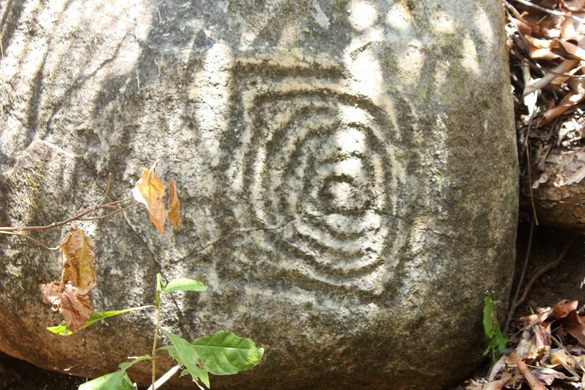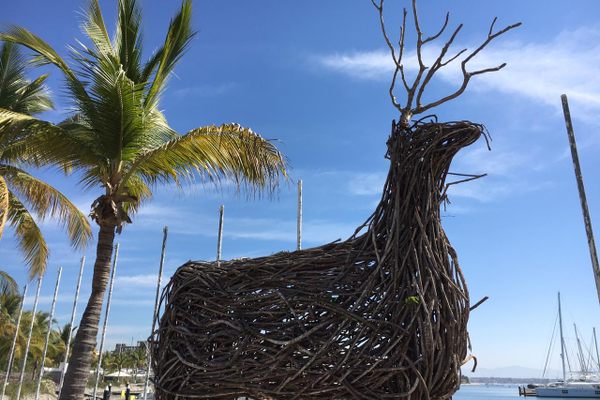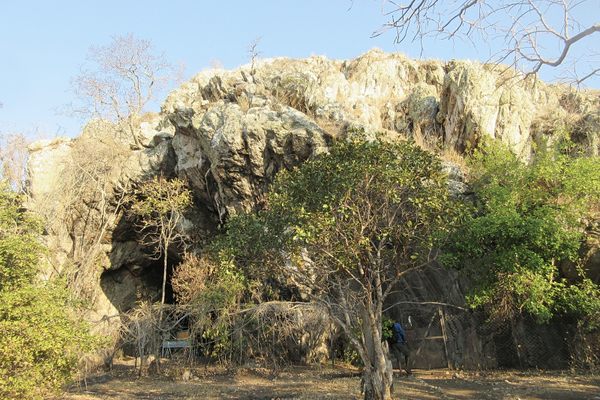Alta Vista Petroglyph Complex
Tucked along a river are enigmatic stone carvings created thousands of years ago.
Along the Las Piletas river in Nayarit, Mexico, stands a cluster of mysterious stone carvings, the Alta Vista Petroglyph Complex. Among the engraved pictures are the evocative and powerful mages of a man with a head of corn, a spiral-like vortex, and a crying face.
These and other sacred stones stand in the river itself, along the overgrown banks, and in the surrounding hillside. Though the exact date of their creation is unknown, these petroglyphs are estimated to be thousands of years old, created by the Tecoxquines, or Throat Cutters.
Some of the images are laid out with colorful offerings, like God’s eyes and other woven votive contributions, painted carvings, or small pieces of food, left by local Huichol, who still venerate this sacred space.
Weathered signage posted here and there tells a disjointed story of this site. The petroglyphs, however, reflect a state of mind that existed long before the documented Spanish enslavement of the Tecoxquines and their eventual annihilation through mistreatment and disease. These petroglyphs are an attempt to connect with a supernatural energy that controlled the seasons, harvests, and lives of the Tecoxquines.
There are over 50 known Alta Vista petroglyphs, though others likely haven’t been uncovered yet. Several of these stone engravings are most arresting, including the human figure with arms and legs and an ear of corn for a head; the spiral vortices; and the large stone face planted in the river bed, eroded somewhat over the centuries as water flowed over and around it.
The human form with the ear of corn head, referred to as Maize Man, is the personification of corn, perhaps the single most important agricultural invention of the Americans. Around 5000 BC, indigenous people in what is now Oaxaca, just south of Nayarit, hybridized a native grass called teosinte and produced, for the first time, what we know as corn. The Tecoxquines likely appealed to the energy represented by Maize Man to sustain the growth of corn, with supplication and thanks given in the form of offerings.
Vortices represented in several locations at the Alta Vista Petroglyph Complex are like spiral graphics seen in other parts of the world, including the American Southwest, where they’re said to be of Ancestral Puebloans origin. It’s possible these vortices represent energy, pulsing outward from a central point, much as the sun’s rays radiate and nourish the plants of the earth that in turn nourish the people of the earth. One feasible interpretation of these vortices is that they represent the sun itself.
The large stone face with the two horizontal slits and verticals beneath suggest a crying face. Tlaloc, one of the most powerful of the Aztec gods, had a temple in the center of Tenochtitlan, what is now Mexico City. Excavations of old Tenochtitlan have uncovered busts of Tlaloc weeping. Like the similarly named Chaac of the Maya, Tlaloc is a rain deity, and rain was an invaluable natural blessing for Aztec, Maya, and other civilizations of North America. The tears of Tlaloc are analogous to the rain that the indigenous people of Mexico and Central America so dearly needed for their survival. On the stone face, the jagged line next to the horizontal slits could be a lightning bolt, also a signifier of rain. This stone figure is set in the Las Pietas river itself; at certain times of the year, it would be partially or completely submerged in water, the blessing the stone face sought to bring forth.
Together, corn, sun, and water, memorialized in stones around and within the Las Piletas arroyo, represent three powerful images of the natural world revered in the past, and still to this day, by the people and who come to the Alta Vista Petroglyph Complex.
Know Before You Go
The Alta Vista Petroglyph Complex is not easy to find. Blasting along Mexico highway 200, you could easily miss the small turnoff that leads to the petroglyphs. Head north along the coast from Punta Mita, and you won’t spot any signs indicating where to turn off the highway. Once you guess the right road to take, there’s no signage indicating which trail you follow to find the carvings. It’s easy to get lost.
You will want a guide or a local driver who knows the area. If you find someone to take you, bring insect repellent, sunscreen, water and maybe some snacks; there is nothing sold at the site of the petroglyphs, though there is sometimes a “guard” who will take an admission fee of one dollar or so per person.



















Follow us on Twitter to get the latest on the world's hidden wonders.
Like us on Facebook to get the latest on the world's hidden wonders.
Follow us on Twitter Like us on Facebook